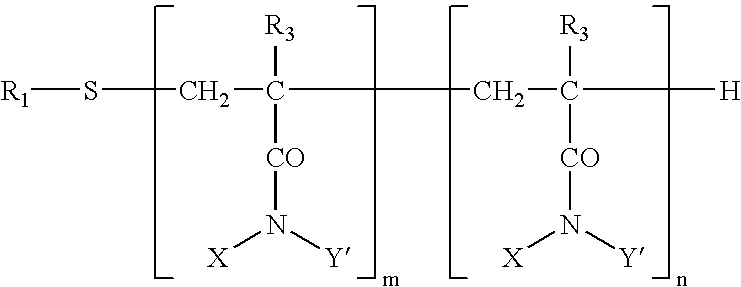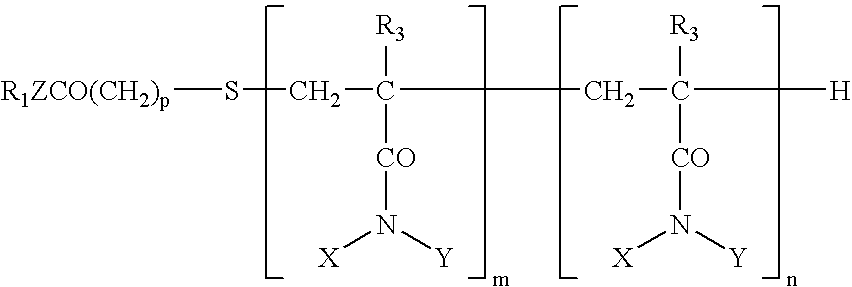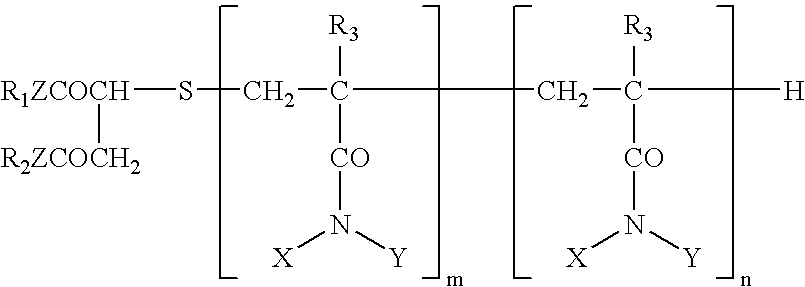Polymer particle stabilized by dispersant and method of preparation
a technology of dispersant and polymer particles, which is applied in the field of water dispersible polymer particles stabilized with dispersant, can solve the problems of unwanted components, suggest their usefulness in stabilizing, and complicate the process of dispersing
- Summary
- Abstract
- Description
- Claims
- Application Information
AI Technical Summary
Benefits of technology
Problems solved by technology
Method used
Image
Examples
synthetic example 1
Synthesis of Dispersant 1
[0117] Acrylamide (35.50 g, 0.50 moles) and 1-dodecanethiol (10.10 g, 0.050 moles) were suspended in ethanol (250ml) under nitrogen atmosphere in a 1 L three necked round bottomed flask equipped with a reflux condenser. The solution was stirred and degassed with nitrogen for 20 minutes. Stirring was continued and the temperature raised to 70° C. over a period of 20 minutes during which time the reagents dissolved. 2,2′-Azo-bis(2-methylpropionitrile)[AIBN] (1.00 g, 6.10 mmoles) was added to the stirred solution at 70° C. and heating continued for 4 hours under the control of an automated reactor system. During this time a white suspension formed. After cooling, the resulting white precipitate was filtered under suction and dried in vacuo to give a white powder (39.6 g, 87%). Analysis of this product was consistent with the desired product.
synthetic example 2
Synthesis of Dispersant 2
[0118] Dispersant 2 was synthesized using the same procedure as Dispersant 1 except that a higher mole ratio of acrylamide to dodecanethiol (20: 1) was used.
synthetic example 3
Synthesis of Dispersant 3
[0119] N-acryloyl tris(hydroxymethyl)aminomethane (52.5 g, 0.40 mol), hexadecyl mercaptan (5.20 g, 0.20 mol), and AIBN (0.20 g) were placed in a 3-neck flask containing methanol (100 ml). The reaction was bubble degassed with argon for 20 minutes and heated at reflux under argon for 6 hours. On cooling, a sticky, white mass had formed in the solution. The methanol was decanted and the product was redissolved in water. Freeze drying gave a white solid (40.5 g, 70%).
PUM
| Property | Measurement | Unit |
|---|---|---|
| median diameter | aaaaa | aaaaa |
| size | aaaaa | aaaaa |
| specific surface area | aaaaa | aaaaa |
Abstract
Description
Claims
Application Information
 Login to View More
Login to View More - R&D
- Intellectual Property
- Life Sciences
- Materials
- Tech Scout
- Unparalleled Data Quality
- Higher Quality Content
- 60% Fewer Hallucinations
Browse by: Latest US Patents, China's latest patents, Technical Efficacy Thesaurus, Application Domain, Technology Topic, Popular Technical Reports.
© 2025 PatSnap. All rights reserved.Legal|Privacy policy|Modern Slavery Act Transparency Statement|Sitemap|About US| Contact US: help@patsnap.com



